Figure shows a point source P inside a water container. Three rays A,B and C starting from the source P are shown up to the water surface.
(a) show in the diagram the path of these rays after striking the water surface. The critical angle for water-air surface is 48∘. (b) Name the phenomenon which the rays A, B and C exhibit.
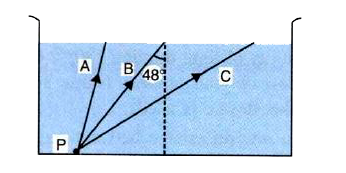 .
.
Step by step video & image solution for Figure shows a point source P inside a water container. Three rays A,B and C starting from the source P are shown up to the water surface. (a) show in the diagram the path of these rays after striking the water surface. The critical angle for water-air surface is 48^(@). (b) Name the phenomenon which the rays A, B and C exhibit. . by Physics experts to help you in doubts & scoring excellent marks in Class 10 exams.
Updated on:21/07/2023Topper's Solved these Questions
- REFRACTION OF LIGHT AT PLANE SURFACESBOOK - ICSECHAPTER - REFRACTION OF LIGHT AT PLANE SURFACESEXERCISE - EXERCISE-4(D) MULTIPLE CHOICE TYPE
3 Videos
- REFRACTION OF LIGHT AT PLANE SURFACESBOOK - ICSECHAPTER - REFRACTION OF LIGHT AT PLANE SURFACESEXERCISE - EXERCISE-4(C) NUMERICALS
3 Videos
- REFRACTION OF LIGHTBOOK - ICSECHAPTER - REFRACTION OF LIGHTEXERCISE - DIAGRAM BASED MCQ:
5 Videos
- REFRACTION THROUGH A LENS BOOK - ICSECHAPTER - REFRACTION THROUGH A LENS EXERCISE - EXERCISE-5(D) (MULTIPLE CHOICE TYPE)
2 Videos
Similar Questions
The diagram below shows a point source P inside a water container. Four rays A, B, C, D starting from the source P are shown up to the water surface.
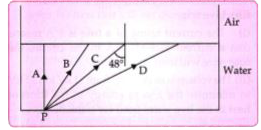
Show in the diagram the path of these rays after striking the water surface. The critical angle for water air surface is 48∘.
View SolutionThe diagram below shows a point source P inside a water container. Four rays A, B, C, D starting from the source P are shown up to the water surface.
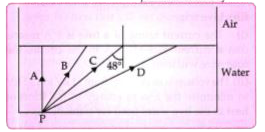
Name the phenomenon which the rays B and D exhibit.
View SolutionA ray of light travels from water to air as shown in the diagram given below:
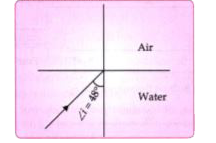
Copy the diagram and complete the path of the ray. Given the critical angle for water is 48∘.
View SolutionState the approximate value of the critical angle for (a) glass-air surface
(b) water-air surface.
View SolutionFigure shows the section of a semi-circular glass slab having its centre at O. three rays of light A,B and C of the same colour are incident on the slab and strike on the edge XY at the point O. the light ray B suffers refraction along OB'.
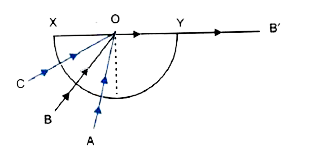
(a) On the diagram, mark the critical angle by C.
(b) The rays enter the slab undeviated. give reason.
(c) Draw the path of rays A and C after they strike the edge XY.
(d) Name the phenomenon which the rays A and C exhibit.
View SolutionA ray of monochromatic light enters a liquid from air as shown in the diagram given below:

Copy the diagram and show in the diagram the path of the ray of light after it strikes the mirror and reenters the medium of air.
View SolutionFigure below shows a light ray of green colour incident on the prisms A,B and C. in each case, draw the path of the ray of light as it enters and emergest out of the prism. Mark the angle wherever necessary.

View SolutionA container contains water up to a height of 20 cm and there is a point source at the centre of the bottom of the container. A rubber ring of radius r floats centrally on the water. The ceiling of the room is 2.0 m above the water surface. (a) Find the radius of the shadow of the ring formed on the ceiling if r = 15 cm. (b) Find the maximum value of r for which the shadow of the ring is formed on the ceiling. Refractive index of water =4/3.
View SolutionFigure alongside shows two rays A and B travelling from water to air. If the critical angle for water-air surface is 48∘, complete the ray
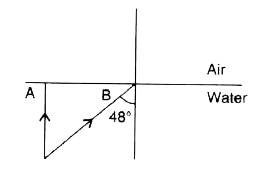
diagram showing the refracted for each. State conditions when the ray will suffer total internal reflection.
View SolutionA point source is placed at a depth h below the surface of water (refractive index =μ). The medium above the surface area of water is air from water.
View Solution
